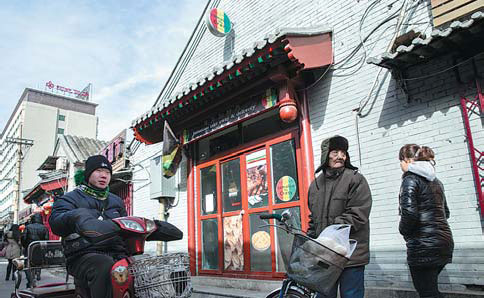
To the North
A European doesn’t travel halfway around the world just to see a former colony that in many aspects resembles his homeland. I wanted to meet the unknown and indulge in my fascination for China. In my mind, China was still an exotic entity conveyed to me through films like The Last Emperor and Once Upon a Time in China. In short, after Macao I wanted to delve deeper into the Far East, and this meant heading north.
I’d heard that the train trip from Shenzhen, an hour’s ferry ride from Macao, to Beijing is scenic and well worth the 24 hours spent aboard. Owing to time restrictions, however, I decided to take a flight and rushed through Shenzhen by taxi to the airport. Our taxi driver did not speak English. I do not speak Cantonese, nor Mandarin. To indicate my destination, I extended my arms out and mimicked a jet taking off. Message received – the driver smiled and took me straight to my terminal.
Arriving in Beijing, the capital felt like a giant village. Its broad avenues are endless, but just behind them lie a myriad of crisscrossing hutongs, or alleyways. Leave an avenue and enter a hutong, and you feel like you’ve discovered time travel.
The avenues are the arteries of modern Beijing. Vehicles dance to a chaotic rhythm, part of the grand symphony of the city. Drivers honk to overtake other cars, honk as a warning to potential jaywalkers, and honk – it seems – just for the fun of it. Pedestrians cross wherever they can, often stopping cars to do so. Add a swarm of bicycles to the mix, and you get the idea. But somehow, the traffic keeps flowing. I saw remarkably few accidents. It’s all a metaphor for how the capital just works, despite the enormous population, despite the rip-roaring construction.
The Chinese capital city offers climactic peace for European visitors, especially those, like me, who arrive from the humid south of the country. The skies in Beijing and Macao bore resemblances. Macao’s was gray most of the time – pregnant with heavy rain. Beijing’s was gray also, though if I looked close enough I could make out the yellowish tinge of pollution on the horizon. The gray was smog – that wonderful English portmanteau that combines “smoke” and “fog.”
I had to look a little harder, but I eventually found many lovely parks in Beijing. The scenes were similar to those in Macao – slow bodies moving gracefully to Tai Chi, frantically diving figures engaged in serious games of shuttlecock, and old men showing off their footmanship with China’s version (the original) of a hacky sack.
My quest to find the ancestral spirit of Beijing led me to some of its best-known tourist destinations, including the Forbidden City, Tian’anmen Square, Jingshan Park, and the Temple of Heaven. But I found it hard to feel the original essence of those places – tourists were simply everywhere.
The hutongs saved me. It was in the winding alleyways that the tourist chatter of familiar European languages died away, and I finally got a taste of Old Beijing. It still exists! There it is, in the hutongs, among the old men playing Chinese chess on the sidewalk, among the young children sitting on the stairs leading up to old courtyards eating bowls of rice. I felt like a stranger and a tourist pulling out the camera in the hutongs – the people in my photographs, after all, were just carrying about their normal lives.
My advice to any potential visitor to Beijing is to go and get lost in those ancestral alleys. To know Old Beijing requires walking, and plenty of it. Walk, and you’ll discover small streets with beautiful rooftops and grand old walls. Color defines the buildings of the hutong areas – yellow, green, red and blue, just name a few. Bikes are parked everywhere; unlike on the avenues, the cars are the odd ones out. Trees arch out above you, and their foliage hides you from the sun.
In the hutongs, it’s quiet, and hard to believe you’re standing in the center of one of the world’s largest cities. You hear nothing but locals walking and chatting, and maybe a rickshaw driver calling for customers.
For sure, Macao is a blend of East and West. The traditional fights for space alongside the modern; tai chi practitioners hone their art on a square in front of a neon-lit casino. But in Beijing, the traditional doesn’t fight – it’s already carved its own space out of the heart of the city, and lives on there on its own terms. For “the Real China” head to the hutongs. But make sure you do it on the sly, so as to not disturb the peace.
